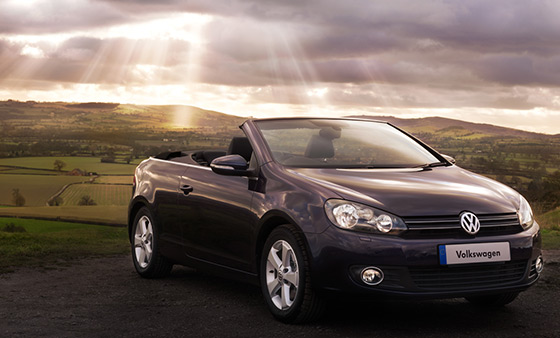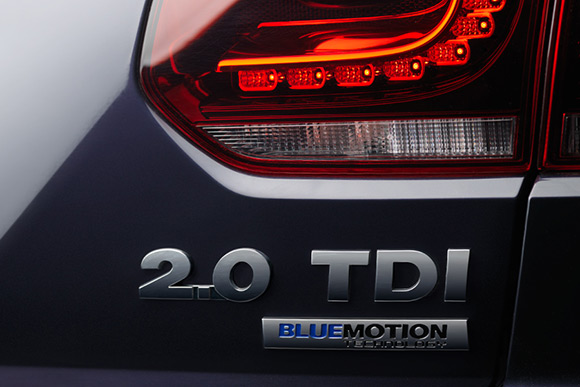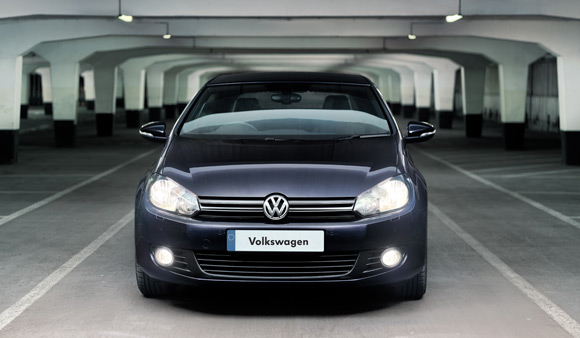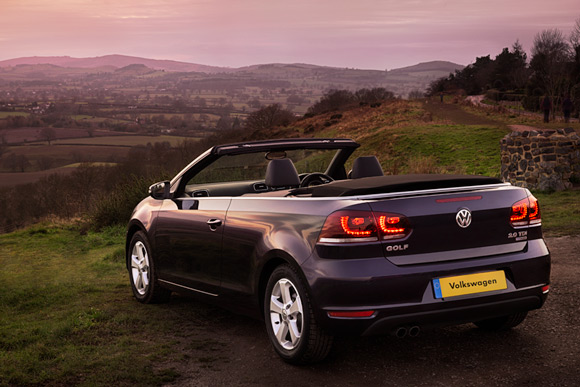
The VW Golf Cabriolet is an icon among convertible cars. In 1980, it was among the very first convertible version of a hatchback car and in sales terms at least, it has probably been the most successful. It is always going to be tough redesigning such a well loved car but with the previous model being phased out some 9 years earlier there was much anticipation for the new generation Golf.
The reason for the delay was probably because Volkswagen Group already had the market for small four-seat convertibles well covered. They had the funky Beetle Cabrio for fun-loving young people, the more grown up hard-top Eos and also the fabric-roofed Audi A3 Cabriolet. With the latter being phased out in 2013 VW jumped on the opportunity and used much of the technology used in the A3 (itself based on the Golf platform) to create the new Golf Cabriolet.
The visual design is clearly based on the Mk 6 VW Golf but with a lower roofline and steeply raked windscreen it has a more sporting look. The styling is smart and conservative; attracting agreeable comments from passers-by rather than open-mouthed stares. Golf Cabriolet drivers aren’t looking to make a statement, those wanting attention are better catered for with the latest VW Beetle Cabriolet. What the Golf does best is almost everything else. Smart, economical and good to drive, there is a lot to like. The ride, build quality and equipment levels are all class leading and it has a familiarity to it which makes the car very easy to live with.
Interior
Volkswagens have long had good build quality but in recent years they have produced some top class interiors that are really pushing sister brand Audi to stay ahead. Materials feel premium, fit and finish are spot-on and standard equipment levels are great. There is lots of room in the front with a wide range of adjustments and firm but comfortable and supportive seats. Unlike many small convertibles, the rear seats are genuinely useable with plenty of headroom for adults. The well thought out design makes you feel at home in no time. All the controls are clearly labelled and right where you expect them to be.
Driving
On the road it’s the same story; the VW Golf Cabriolet is predictable and easy to drive. Small enough to make town driving easy but equally composed on the open road. There is a wide range of engines available, but perhaps the most impressive is the 2-litre turbo diesel driven for this review. While it has had a good dose of VW’s high-efficiency Bluemotion magic, that hasn’t stopped it being either smooth or responsive. The result is a car that is fun to drive and yet uses very little fuel. Even during urban driving VW claim it will return 52 miles to the gallon.

When diesel engines began to make their way into European convertible cars it seemed like a strange idea. The clattery noises and sooty emissions normally associated with diesel engines were completely at odds with the concept of open-air driving. What’s more the benefits of these generally more expensive engines usually only start to make paybacks on high mileage cars which convertibles rarely are. Today, though, cars like the Golf Cabriolet need not be saved for sunny weekends and are practical enough to use as your daily car whatever miles you might cover. In addition, modern diesel engines like this are so smooth and quiet; it is honestly hard to tell the difference.
The other engines include an even more economical (though less powerful) 1.6-litre diesel and a selection of flexible turbocharged petrol engines. The GTI is bound to be great fun while the Golf R Cabriolet offers proper sports car performance to those who can afford it.
The Golf quickly inspires confidence in its driver leaving you feeling in control whether driving at speed or squeezing into a tight parking space. With the roof in place the rear view might not be as good as the hatchback but visibility remains better than many rival convertibles and with the front and rear parking sensors fitted to this car, manoeuvring wasn’t a problem. The chassis offers excellent rigidity with little sign of scuttle shake or vibrations.
The Roof
Using fabric for the roof means that the Golf can keep its compact proportions while not losing most of its luggage space. The multi-layered roof is well insulated to the point that it doesn’t feel like a convertible when the roof is up. Outside noises are deadened and there is no question of drafts or leaks entering the cabin. The standard power-operated roof drops down in under 10 seconds and if the traffic lights are red for less than that, you can finish the operation while driving along up to 19 mph. It folds into a Z shape with the hard front section acting as a tonneau cover holding it all in place.
With the roof down the Golf Cabrio feels that bit more special. The climate control system resets itself to the different environment so that even on the sharp winters days of our test, the cabin can be kept warm and comfortable. With the side windows up there is very little air movement inside the car even at cruising speeds but should you need it and you don’t have any rear seat passengers, Volkswagen include a wind deflector as standard. This is an L-shaped frame covered with a mesh cloth that fits behind the front seats that aims to block wind noise and buffeting but not rear vision. In this car we didn’t really feel a need for it and ironically it’s usually rear seat passengers who suffer the most.
Practicality
The Golf impresses with its ability to comfortably accommodate four adults and luggage within a relatively small car. There aren’t many compromises but while the luggage compartment is a reasonable size (250 litres), access is a little awkward. The vertical door opens upwards and the deep load space is accessed through a relatively small hole. The rear seats can be folded to allow an even larger luggage space but the need for chassis reinforcement leaves a hole only about half the width of the seat itself and with a thick beam at the top. It is a useful feature though, for occasional load lugging. The rear seats also feel a little too upright which is probably a result of trying to get the most out of the given space. Internal storage is excellent with many convenient spaces for both front and rear occupants.
Safety
The VW Golf Cabriolet has clean lines with the roof down; the basket-handle roll bar is now a thing of the past as are the roll hoops seen on the A3. Instead, the Golf has a pair of pop-up roll bars hidden behind the rear seats. These are triggered when the car becomes severally unbalanced and instantly launched into place. These hidden away roll bars that are more often seen (or rather, not) on premium level cars and benefit the driver’s rear visibility as well as providing an improvement to the car’s aesthetics.
A brace of airbags and a stability control system that helps prevent you getting into difficulty, round of the safety features that earned the Golf a five-star Euro NCAP rating.

Conclusion
By almost every conceivable measure it is an exceptional car: compact yet spacious, highly efficient while still being comfortably quick, beautifully well made, comfortable, well equipped, reliable… the list goes on.
The Volkswagen range of cars has pretty much something for everyone with the Golf Cabrio as the central product being the most versatile of them all. While the Golf is a difficult car to fault, VW have an argument for any of its failings. Want a car with more personality? – buy a Beetle Cabrio. Want more space and luggage capacity? – how about an Eos? Looking for something more sporty? – How about the Golf Cabrio GTI, R or even an Audi TT?
Alternatives
VW Beetle Cabriolet 2.0 TDI
The latest Volkswagen Beetle Cabriolet is more sporty than ever before. The previous generation car was clearly aimed at a feminine market with its cute looks and dashboard mounted flower vase, but this car should have a broader appeal. Being based on the same platform as the Golf, it is a similar size and shares its obedient, well-balanced handling. Inside and out it has a more characterful, less sophisticated design and both interior and luggage space suffer as a result.
Mini Convertible
The Mini has been a huge success in the small car market, not least in its convertible form. It boasts great handling and a characterful retro design. The Mini has now become so popular that it is almost a victim of its own success with some drivers now looking for something different. Next to the Convertible Mini the VW Golf Cabriolet looks a lot more grown up. The Golf boasts ‘big car’ sophistication, a higher level of equipment and greater practicality compared to even the top of the range Mini but it can’t beat its driver appeal.
VW Eos Cabriolet
The Eos is larger, heavier and more expensive than the Golf, it also has the attraction of a folding hardtop roof. While the two cars may appear similar at first glance, the Eos shares as much with the larger Passat as it does with its little brother. Next to the Golf the Eos is more of a relaxed cruiser with the clever 5 piece glass roof with sliding sunroof being perhaps the most sophisticated of any convertible car. Although when folded, the roof takes up a good proportion of the luggage space, when it is up the Eos offers a 308 litre capacity compared to the 250 litres of the Golf.
See the Volkswagen Golf Cabriolet 2.0 TDi in our Buyers Guide

Is the VW Golf convt. Available in the USA and what is the price for the diesel version?
Sadly no, this generation of Golf Cabriolet has never been available in the US. The next generation will replace both this car and the Eos and so is much more likely to be sold in America.
The roof looks a bit fragile relyin on that little cable and roof fabric has a couple inch tear in the rear driver side. Do u reckon it’ll become a problem ? Thx
Any news on the new Cabriolet coming to U.S.? I have one and would love it. Eos too boring although know it’s probably a good car.